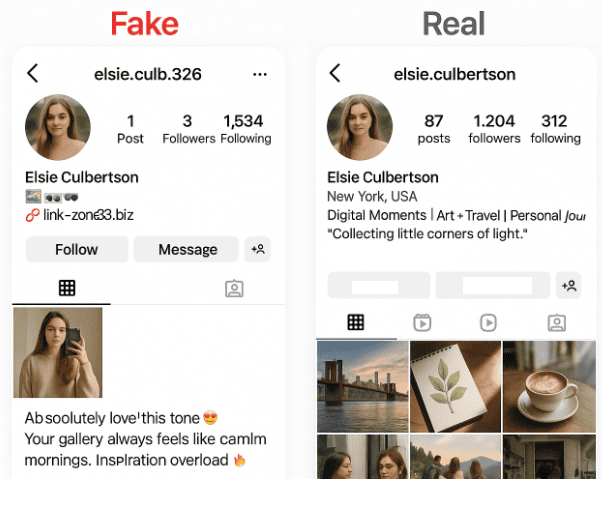Many people today face the challenge of fake Instagram accounts that copy identities, scam followers, or spread misinformation.
The key idea is to analyze the visible profile, reverse image searches, cross-platform discovery, and legal reporting tools. Often, small pieces of data like usernames, captions, and locations can disclose the real person behind the fake page.
One thing to notice is how fake accounts often use odd handles, random numbers, and mismatched photos. In several cases, a quick Google Image or TinEye search shows where the photo was first used, pointing toward the source.
You can try by checking with Instagram’s password-reset feature for redacted contact details without violating privacy. Many investigators also use reverse-lookup sites such as BeenVerified or Spokeo when free searches fail.
The most important rule is to collect evidence i.e. screenshots, timestamps, and URLs, before filing an impersonation report. Instagram’s systems handle impersonation complaints efficiently if provided with factual proof. This guide explains some methods to find a fake Instagram account’s details.
Contents
How To Find Who Is Behind A Fake Instagram Account
By checking the profile and its followers, analyzing pictures with Google Images, reviewing location tags, or using professional lookup tools, you can find out who is actually behind an Instagram account.
1. Check Profile and Followers
You can start by simply looking at the account’s profile details. Fake Instagram accounts often use usernames filled with unnecessary numbers or random letters. The bio is either empty or written with unrelated emojis, links, or copied text.
The follower ratios often appear suspicious, such as an account following thousands but barely receiving any followers in return. The content pattern may include repetitive captions or inconsistent photo quality, which simply means image theft.
It helps to check mutual followers because one familiar contact can confirm whether the person is genuine or fabricated. Often, fake profiles display comments full of spam or identical phrases, signaling automation. Finally, compile this data before submitting an impersonation report to Instagram’s official support portal.

2. Lookup with Google Images
Many fake Instagram users use mostly stolen photographs. You can take a clear screenshot of their profile picture or image and upload it to Google Images. This process helps trace where else the image exists on the internet.
Often, identical pictures appear on other platforms such as LinkedIn, Pinterest, or Facebook, exposing the actual person or the stock-image source. If the image leads to a modeling site or professional portfolio, it becomes evident that the fake user is reusing someone else’s photo.
It helps to check TinEye or Yandex as additional engines because they show different global databases. Some images return results with older timestamps, confirming who originally uploaded them. Just by keeping records of all found URLs, matching profiles, and dates endorses stronger evidence if you need to prove identity misuse later.
3. Location Mentions
Sometimes the smallest detail in captions or hashtags can reveal a fake account’s origin. Many users accidentally share their real area through restaurant tags, event mentions, or local language patterns.
If a profile frequently references particular cities, clubs, or festivals, it helps to cross-check whether those locations align with their claimed identity. However, posting times also tell a lot i.e. daylight photos uploaded at midnight hours suggest the user is in a different time zone. When similar photos appear elsewhere, metadata or EXIF details (if not stripped) may reveal coordinates or timestamps.
Searching those location hints on Google Maps or tagging databases can link the account to a physical region. Now, by combining linguistic patterns, activity hours, and background visuals often narrows down the suspected area from which the fake profile operates.
4. Reset Password Hints (Limited Info)
Instagram’s password reset option can provide subtle hints without breaching privacy. When you use “Forgot Password” and enter the fake account’s username, Instagram sometimes displays partial contact data, such as the first letter of an email address or the last two digits of a phone number.
This limited information is not detailed enough for finding, but it can help verify whether a known contact or region matches. It helps to take a screenshot of the redacted details for your investigation log.
This step is purely observational; never attempt to access another person’s account. The purpose is to gather context only. If you believe the account impersonates someone, report it using Instagram’s impersonation complaint form. Combined with previous methods, this small clue can confirm whether the fake page links to a specific user.
5. Search on Other Social Media
When investigating a fake account, it helps to expand beyond Instagram. Most individuals reuse usernames, display names, or profile images across multiple platforms. By typing the same handle in Google with quotation marks or using “site:” filters (like site:facebook.com or site:twitter.com), you can reveal duplicates.
Often, you’ll find a matching profile with real personal details, confirming the person’s main account. If you want to check LinkedIn, TikTok, and other major sites, it might show professional or verified profiles under that username.
Reverse-searching the profile photo across platforms frequently exposes links between accounts. In some cases, the same email or phone number appears in multiple bios, strengthening identification. Always collect your results methodically and never message or accuse the discovered person directly. Once verified, submit a formal report to Instagram with evidence from all social media platforms.
6. Reverse Lookup
The reverse lookup tools help when free searches fail, as they collect public records, social links, and phone data into compiled reports that may identify the person running a suspicious account.
i) BeenVerified
BeenVerified allows people searches through phone numbers, names, or emails, pulling from public records, criminal history, and social connections into easy-to-read compiled investigative summaries.
✔️ Performs phone, name, and email lookups.
✔️ Searches across social networks and background databases.
✔️ Generates full downloadable PDF reports.
Usually $20–$30 per month, depending on location and promotional offers.
Pros:
✔️ Intuitive interface for beginners.
✔️ Combines multiple data sources efficiently.
Cons:
🚫 Some data may be outdated.
🚫 Requires a paid subscription for most results.
ii) Spokeo
Spokeo is another powerful option that compiles addresses, emails, and social profiles from public databases, helping to cross-match identities tied to fake Instagram or other suspicious accounts.
✔️ Searches phone numbers, emails, and addresses.
✔️ Displays historical address data and related people.
✔️ Finds connected social media profiles.
The plan starts at around $15 monthly.
Pros:
✔️ Comprehensive public data coverage.
✔️ Simple navigation and clear visuals.
Cons:
🚫 Some results may duplicate or mismatch.
🚫 Accuracy varies based on region.
Fake Profile Remover: (by TechniqueHow)
TechniqueHow offers a specialized service called Fake Profile Removal, designed to help you identify and eliminate fake Instagram or social media profiles safely. It helps to use this service whenever someone is impersonating you, misusing your images, or spreading false information.
You’ll need to input the username of the fake account, exactly as it appears on Instagram, or the direct profile link. After that, you are asked to share a short description and what the account is doing, such as copying your profile, impersonating your name, or posting false content.
Once the form is completed, you can submit your details and wait for a confirmation email to arrive. This email usually includes a request for follow-up details or proof, such as screenshots of the fake account or examples of impersonation. It helps to reply promptly to that message to ensure quick progress.
Protect Your Brand
Expert Removal Services
We use documented screenshots, URLs, and timestamps to build strong takedown cases in accordance with platform policies for faster removal and support.
START NOW
How It Works:
➡️ First, proceed with any service as you need, and we will revert to your registered email.
➡️ Provide brief details of what the fake account is doing and your profile with proofs (if available).
➡️ Submit the request, then check your email for confirmation or follow-up questions.
➡️ Once verified, we will coordinate directly with Instagram or other platforms to remove the fake account and send you a final confirmation email.
In several cases, users need to report more than one fake profile. TechniqueHow allows you to include multiple usernames or URLs in a single submission (while you describe the issue), ensuring efficient investigation. If you wish, you can also request a completion report once the removal process is finished, confirming that the fake account no longer exists.
Frequently Asked Questions:
You can still notice small clues like posting times, hashtags, or who follows them. Searching for the same username on other platforms can also reveal useful information about the real person.
It’s better to collect screenshots, links, and dates first. Then report the fake account to Instagram with proof. This makes it easier for them to remove it quickly.
You can manage location sharing in several ways: disable the Map in DMs, set location permissions in profile under privacy, or turn off location services at the device level. Also, avoid geotagging posts or using location stickers, and don’t use “Account based in” info if you don’t want the region shown.

Hi, is it really a crime if I made a fake Instagram account of someone?
Hi, you should know that under the law: 18 U.S.C § 1028, if you are doing identity theft of someone and pretend to be someone then it is a crime.
By tracking the IP, How can I know who the person is?
Hey, Stanley! Once you have the person’s IP address, you can find the location details with it. However, to find the exact person you will need real-time tracking, legally done by the law enforcement.
Hey, I know someone is using Instagram with my name. Does Instagram has the details about who that person is?
Yes, Instagram has all the login details of an account. But, unless you have the court order they would not provide the details to you. You can just manually report an impersonation complaint.
Hello, if I delete the fake Instagram account will Instagram will still have the data? Are they provide details to police?
Hi, Alonzo! Instagram will keep your data for a while after the account is deleted. Also, Instagram can provide the details to police as they are bound to follow law enforcement.